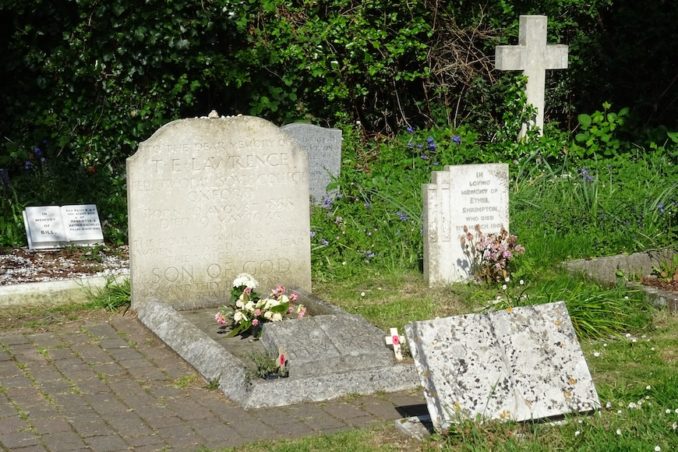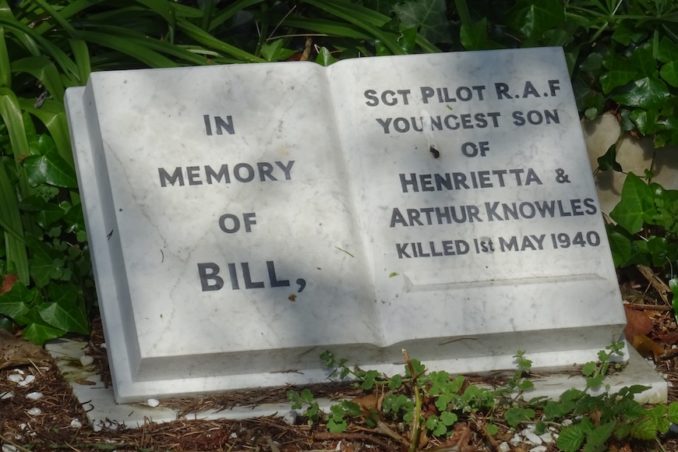During a visit to the Tank Museum at Bovington Camp, Dorset, with my daughter, we decided first to go to the graveyard of the Church of St Nicholas in the village of Moreton in the Purbeck District of Dorset, as it is nearby.
In this graveyard is buried T. E. Lawrence, better known as “Lawrence of Arabia” and one of my “heroes” since childhood. After Lawrence had retired from being an aircraftsman in the RAF, he lived in his cottage “Clouds Hill” in Bovington and near to the village of Moreton, when he was killed in a motorcycle accident on the 19th of May 1935.

© John Tull 2025, Going Postal
His unprepossessing grave, in a quiet back corner at the end of the central path, has no reference to his exploits in the Middle East but instead refers to him only as having been a “Fellow of All Souls College Oxford”, perhaps continuing in perpetuity Lawrence’s post-service wish to be practically anonymous.
Whilst contemplating Lawrence’s grave for the first time, a simple memorial “In Memory of Bill”, situated just behind Lawrence’s headstone, caught my eye.

© John Tull 2025, Going Postal
Who was Bill? As the memorial states, he was a “Sergeant Pilot RAF”, the “youngest son of Henrietta and Arthur Knowles”, killed on the 1st of May 1940.
Intrigued, I decided to research who “Bill” was, which has led to coincidentally finding connections to both the Desert War and an article I was writing for Going Postal.
Rather than simply “Bill”, his actual name was Basil Elles Sharp Knowles and he had been aged just 19 when he was killed in action. His father’s full name was William Arthur Knowles and his mother had been Henrietta Emily Greening before marriage. His parents lived in Wareham in Dorset and, at the time of his death, he was a member of 37 Squadron. As well as the memorial in Moreton, he is also commemorated on the Runnymede Royal Air Force Memorial.
37 Squadron had been originally a Royal Flying Corps squadron, was reformed in April 1937 at RAF Feltwell in Norfolk, and had been equipped with Vickers Wellingtons in May 1939.
In May 1940, RAF No. 3 Group squadrons, including 37, were supporting the British and Norwegian forces opposing the German invasion with operations against occupied airfields and seaplane bases.
On the 2nd of May 1940, the Blenheim Squadrons were withdrawn to be prepared to support the British Expeditionary Force against the anticipated invasion of France, leaving the Vickers Wellington, Armstrong-Whitworth Whitley and Handley-Page Hampden bomber squadrons to continue limited operations until the final withdrawal of British forces in Norway took place in mid-May.
Bill Knowles was a member of the crew of P9213, a Vickers Wellington Mk.1a with the marking “LF-B”, when he went on his final bombing mission to Norway. The Wellington normally had a crew of 5, usually composed of a Pilot, Radio Operator and Observer in the cockpit, and a Gunner in each of the Front and Rear Turrets. The “Observer” usually being both the Navigator and Bomb Aimer.
His pilot was Squadron Leader Ridley Lewkenor Bradford, aged 28, and the son of Colonel Sir Evelyn Ridley Bradford and Lady Bradford, of Medstead, Hampshire, and the Observer was Pilot Officer James Douglas Morrison, aged 19, who was from Regina in Saskatchewan, Canada.
The other crew members were Sergeant James Thomas Bowen, aged 39, the son of James and Emma Bowen of West Bromwich, Staffordshire; Leading Aircraftman Eric William Burnett, aged 25, the son of Benjamin Vickers and Ethel Jane Burnett of Ilford, Essex; and Leading Aircraftman Philip Andrew Tyler, aged 24, the son of Fredrick and Ellen Mary Tyler of Stratford-on-Avon, Warwickshire.
As there were 6 crew on the P9213, one of them may have been acting as a second pilot to gain experience, although the Wellington did not have a second pilot position, or possibly in one of the Observer’s roles.
They left RAF Feltwell at 17:35 hours on the 30th of April 1940 on a bombing mission to Stavanger Airfield, Rogaland; however, whilst approaching the Norwegian coast, their aircraft was shot down by a German fighter and crashed into the sea, killing all six crew members. The bodies of the crew were not recovered.
The 26-year-old Luftwaffe pilot that shot them down was Oberfeldwebel Erwin Sawallisch, flying a Messerschmitt 109. He was a veteran of the Spanish Civil War, having served with the Condor Legion in Spain, and had joined 4. Staffel of Gruppe II of Jagdgeschwader 77, known as the Herz As (“Ace of Hearts”), on the 30th of October 1939.
JG77 had supported Operation Weserübung, the invasion of Denmark and Norway, in April 1940 and were now based on occupied airfields in Norway.
Erwin Sawallisch had already claimed 3 kills since the beginning of the war. In 1939, on the 30th of October, he shot down a Bristol Blenheim north-east of Helgoland in the German Bight and, on the 14th of December, first a Vickers Wellington at 15:28 whilst north of Wangerooge, a Frisian Island close to Denmark, then a second Wellington at 15:30, again north of Wangerooge. On the 30th of April 1940, he claimed a third Wellington, Bill’s plane, shot down at 20:50 south-west of Stavanger. He went on to shoot down a Blackburn Skua on the 13th of June and, on the 6th of September, a Lockheed Hudson.
After leaving service in Norway in November 1940, Erwin Sawallisch flew for a time in Greece before going on to fly with JG27 in the Soviet Union in 1941. He should then have gone for a rest period as an instructor but instead volunteered in 1942 to continue to serve with JG27 in Libya.
Whilst in Libya, he took off in a Messerschmitt 109 during the early afternoon of the 19th of August 1942, supposedly on a test flight and from which he failed to return. The next day, his body was washed ashore and the reason for his death was officially identified as unknown.
However, he was under investigation at the time as being a member of the so-called “Experten-Schwarm”, a group of JG27 pilots who had been suspected by older, more experienced pilots in the squadron of falsifying victory claims and who appeared to have accrued a large number of kills despite being in a relatively quiet sector, undertaking interdiction missions against shipping. There was also a claim from a more senior pilot that they had been seen having a mock dogfight over the desert for which subsequent kill claims had apparently been made.
As Erwin Sawallisch went missing on the day after they were accused of making these false claims, it is reasonable to now assume his death may have been suicide. The other pilots involved were intended to be sent separately to other units in Germany to avoid bringing disgrace on JG27; however, as Rommel was about to launch a major offensive in which all pilots would be needed, this did not happen.
In November 1940, 37 Squadron were sent to the Middle East via Malta and, after arrival in Egypt, were deployed in support of Operation Compass, the British offensive against Italian forces in the Western Desert. After this, they were transferred to Greece in February 1941 but returned to Egypt ahead of the German advance.
On the 1st of May 1941, a detachment of eight Wellingtons from 37 Squadron were deployed to RAF Aqir in Palestine and, the next day, took part in bombing raids against Iraqi positions outside RAF Habbaniya in what were the opening moves of the Anglo-Iraqi War, which will be featured in my next Going Postal article “Desert Mystery – Cartoons on a Wall”.
© John Tull 2025



